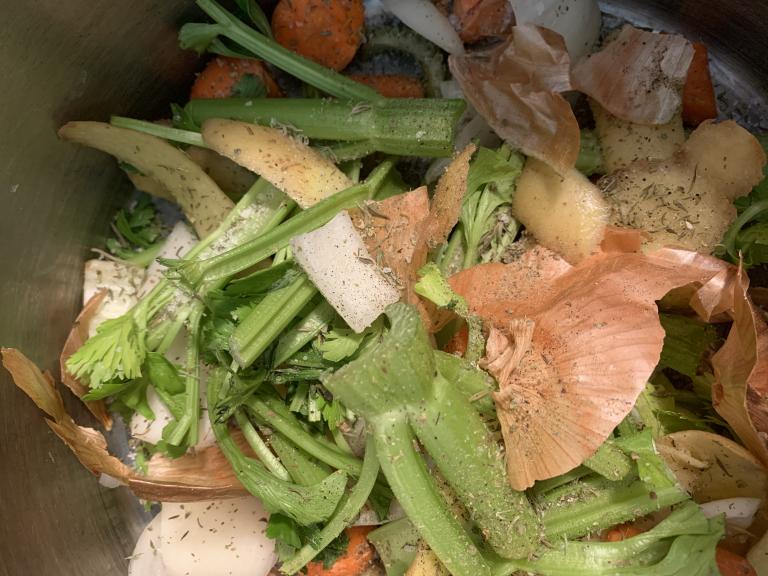I’ve had folks reach out to me recently looking for cooking tips and tricks. As it turns out, more people than I expected don’t cook at all, or cooking means defrosting a meal or reheating some pre-prepared food. Nothing wrong with that at all, unless you find yourself stuck at home, for weeks on end, with time on your hands and food in the fridge. One of the easiest things and most versatile things to make is vegetable stock.
Stock: Waste Nothing
Food resources are precious resources and folks are really coming to understand that now. Part of kitchen witchery, and cookery in general, is knowing what to do with the ingredients you have on hand. There’s nothing worse than spending money and then throwing out food that spoiled because it got lost in the back of the fridge.
One practical, cost-saving, nutritious, and incredibly simple way to use what you have, is to make stock. Stock makes a great base for soups. You can substitute it in recipes that call for water. Stock is a great way to flavour rice and mash potatoes. You can even drink it just as it is, as a tasty, hot beverage.

Stock: What Can You Put In It
For a vegetable stock, I love to use all the left over bits and pieces. Practically everything goes in my pot. I keep a plastic bowl, with a lid, handy. I put all the end pieces and peels and what not into the bowl and keep it in the fridge. When it’s full (about 4 cups), I make stock.
If you look online, you’ll see a gazillion recipes for stock. Some call for you to use whole onions and carrots and such. That’s a great idea if you have a ton on hand, but using scraps and leaves and end bits, means you can use the whole veggies in another recipe.
Quick note for those of you that don’t make stock: Once it is cooked, you throw away the veggies that are all cooked down. That’s why I like to use scraps instead of whole vegetables.
- Onions ends & skins
- Carrot tips & ends
- Celery tips & ends (those leaves are delish!)
- Potato peels
- Garlic cloves and skins
- Mushrooms stems
- Leeks (the green bits)
- Asparagus (those hard woody bits)
- Corn cobs
- Pea Pods
- Green bean tips
- Turnips skins
- Sweet potato ends & skins
- Greens (like chard, beet greens, dandelions, and nettles)
- And every “green” spice or herb I have, like parsley, thyme, oregano, marjarom, rosemary, bay leaves, and savory
Vegetables I avoid using:
- Lettuce
- Broccoli
- Cabbage
- Beets
Stock: How To Make It
- Get the biggest pot you have. Turn the heat on high. Add two tablespoons of oil (vegetable, olive, coconut) and let it get hot (about 1 minute).
- Toss in your 4 cups (or more) of vegetable bits and pieces.
- Add 4 tablespoons of dried herbs in whatever combination you have. If you have fresh herbs, use them too. Double the amount of fresh herbs to dry herbs.
- Add two tablespoons of salt and two tablespoons of black pepper.
- Give everything a good stir with a big wooden spoon. Let the vegetables and herbs saute for 3 minutes. Stirring occasionally, so nothing sticks to the bottom of the pot.
- Add 8 cups (2 quarts or 2 litres) of water and bring the covered pot to a boil. Then turn it down to a simmer and let it just sit there for at least 30 minutes. I leave mine for an hour. Your kitchen will smell wonderful!
- Get a big bowl and a strainer. Pour the broth through the strainer. Discard the vegetables.
- Once the broth has cooled, I usually divide it equally into either Ziploc bags or Tupperware containers (with lids). Write the date with a Sharpie and freeze if you’re not using it right away. Stock will keep in the fridge for 3 days and in the freezer for a month.
Stock Is Magick
Why is stock magical? Well, you’re kinda making something out of nothing. You’re using what you have on hand. It certainly looks very witchy, when you’re huddled over your giant cauldron (stock pot), stirring in a little of this and a dash of that. And, most importantly, you’re brewing comfort. Knowing that you’ve put cast off ingredients to good use and have them for the future is comforting.
Stir in your best intentions – “May this stock feed those that need it” – “May this stock bring joy and nutrition to those that eat it” – “May I use my resources well, today and tomorrow” – and you’ll really have a magical potion on your hands.
Happy stock making folks!
Note: Hit me up in the comments if you want a recipe for chicken or beef stock. Also, there’s a great beef bone broth recipe in my book “The Magick Of Food”


















